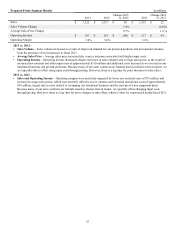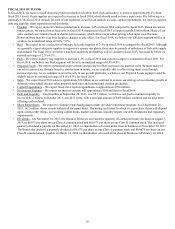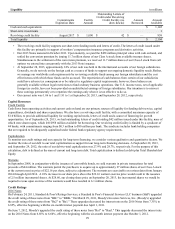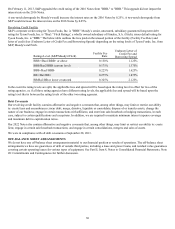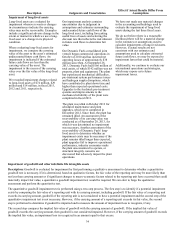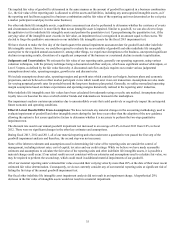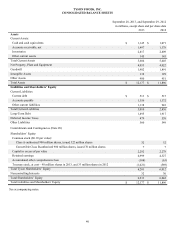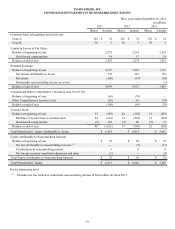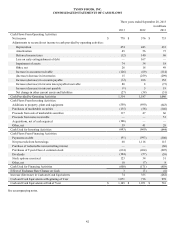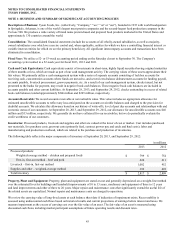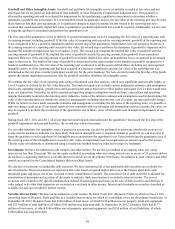Tyson Foods 2013 Annual Report Download - page 34
Download and view the complete annual report
Please find page 34 of the 2013 Tyson Foods annual report below. You can navigate through the pages in the report by either clicking on the pages listed below, or by using the keyword search tool below to find specific information within the annual report.
34
Description Judgments and Uncertainties Effect if Actual Results Differ From
Assumptions
Impairment of long-lived assets
Long-lived assets are evaluated for
impairment whenever events or changes
in circumstances indicate the carrying
value may not be recoverable. Examples
include a significant adverse change in the
extent or manner in which we use a long-
lived asset or a change in its physical
condition.
When evaluating long-lived assets for
impairment, we compare the carrying
value of the asset to the asset’s estimated
undiscounted future cash flows. An
impairment is indicated if the estimated
future cash flows are less than the
carrying value of the asset. The
impairment is the excess of the carrying
value over the fair value of the long-lived
asset.
We recorded impairment charges related
to long-lived assets of $74 million, $29
million and $18 million, in fiscal 2013,
2012 and 2011, respectively.
Our impairment analysis contains
uncertainties due to judgment in
assumptions and estimates surrounding
undiscounted future cash flows of the
long-lived asset, including forecasting
useful lives of assets and selecting the
discount rate that reflects the risk inherent
in future cash flows to determine fair
value.
Our Dynamic Fuels consolidated joint
venture began commercial operations in
October of 2010 and has incurred net
operating losses of approximately $38
million since then. At September 28,
2013, Dynamic Fuels had $166 million of
total assets, of which $142 million was net
property, plant and equipment. The plant
has experienced mechanical difficulties,
pre-treatment system performance issues
and hydrogen supply disruptions, which
have contributed to plant down time and
higher than expected operational costs.
Upgrades to the feedstock pre-treatment
systems and improvements to the
mechanical reliability of the plant were
completed in fiscal 2013.
The plant was idled in October 2012 for
scheduled maintenance and plant
upgrades, which were completed in
December 2012. Since then, the plant has
remained idled. An assessment of the
recoverability of its carrying value was
conducted as of September 28, 2013, for
which it was determined no impairment
was necessary. Another assessment of the
recoverability of Dynamic Fuels' long-
lived assets to determine whether an
impairment exists may be necessary if the
plant remains idled longer than expected,
plant upgrades fail to improve operational
performance, industry economics make
the plant uneconomical to operate, or
structural integrity concerns are
discovered that adversely impact the plant
operations.
We have not made any material changes
in the accounting methodology used to
evaluate the impairment of long-lived
assets during the last three fiscal years.
We do not believe there is a reasonable
likelihood there will be a material change
in the estimates or assumptions used to
calculate impairments of long-lived assets.
However, if actual results are not
consistent with our estimates and
assumptions used to calculate estimated
future cash flows, we may be exposed to
impairment losses that could be material.
Additionally, we continue to evaluate our
international operations and strategies,
which may expose us to future
impairment losses.
Impairment of goodwill and other indefinite life intangible assets
Description: Goodwill is evaluated for impairment by first performing a qualitative assessment to determine whether a quantitative
goodwill test is necessary. If it is determined, based on qualitative factors, the fair value of the reporting unit may be more likely than
not less than carrying amount or if significant changes to macro-economic factors related to the reporting unit have occurred that could
materially impact fair value, a quantitative goodwill impairment test would be required. We can elect to forgo the qualitative
assessment and perform the quantitative test.
The quantitative goodwill impairment test is performed using a two-step process. The first step is to identify if a potential impairment
exists by comparing the fair value of a reporting unit with its carrying amount, including goodwill. If the fair value of a reporting unit
exceeds its carrying amount, goodwill of the reporting unit is not considered to have a potential impairment and the second step of the
quantitative impairment test is not necessary. However, if the carrying amount of a reporting unit exceeds its fair value, the second
step is performed to determine if goodwill is impaired and to measure the amount of impairment loss to recognize, if any.
The second step compares the implied fair value of goodwill with the carrying amount of goodwill. If the implied fair value of
goodwill exceeds the carrying amount, then goodwill is not considered impaired. However, if the carrying amount of goodwill exceeds
the implied fair value, an impairment loss is recognized in an amount equal to that excess.



